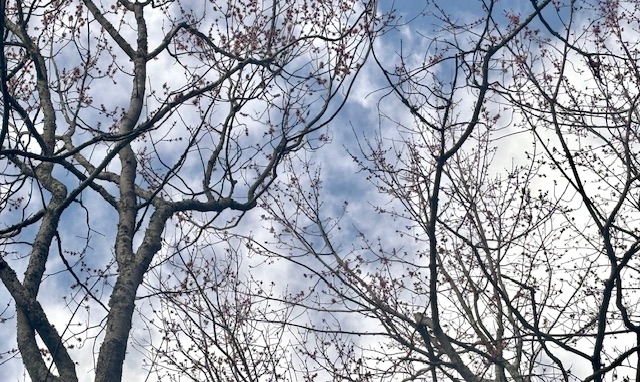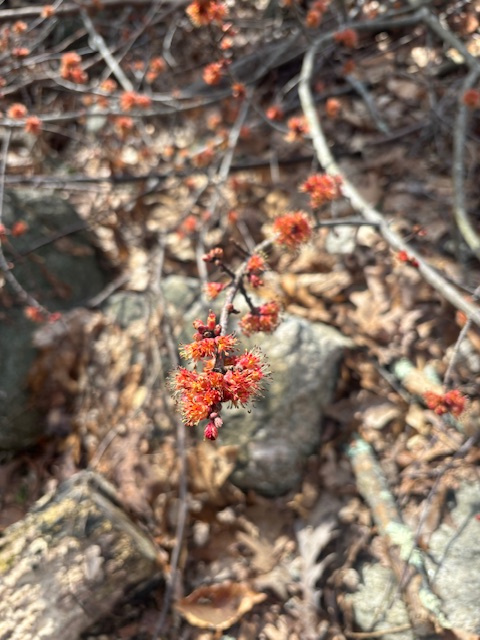
The eastern red maples silhouetted against the sky at the Colhoun meadow are pictured above. The red buds are actually flowers that need to be pollinated to produce viable seeds. To enable fertilization, the pollen must be transferred between the stamen (male parts of flowers) and the stigma (female parts). Over millennia, maples, other trees, and flowering plants have developed several strategies to accomplish pollination and ensure the survival of their species.
Many native canopy and understory trees flower early in the spring before the leaves unfold. Most canopy trees, including oaks, ash, elms, birch, and cottonwood, are wind-pollinated. They release large amounts of pollen directly into the air to be dispersed by the wind. Many conifers, including pines, spruce, and junipers, do the same. Generally, the flowers of wind-pollinated trees contain pollen but no nectar. As these trees don’t rely on pollinating insects for fertilization, they do not need to expend extra energy to produce nectar to attract them.
Most understory and some canopy trees have co-evolved with pollinating insects and rely on them to fertilize their flowers. They produce both pollen and nectar and flowers that are often showy and strongly scented to entice insects to visit.
Here is a look at three common native trees and how they are pollinated.

Eastern Red Maple
Eastern red maples (Acer rubrum) are tall canopy trees native to the eastern U.S. and Canada. They reproduce readily as they have evolved to benefit from three pollination strategies.
Red maples are polygamo-dioecious, which means the trees can produce all male flowers, all female flowers, or a combination of both on alternating branches. In other words, the trees can be male, female, or bisexual. This enables them to be cross-pollinated by wind and/or insects or to self-pollinate on trees that bear male and female flowers in close proximity.
Cross-pollination between trees is preferable as it expands the gene pool. While self-pollination restricts genetic diversity, it enables trees to reproduce if they happen to flower when winds are minimal or capricious or if the temperatures are too cool for insects to be active.
Red maples are one of the first trees to flower in the spring. They bloom in mid-March, often before other trees, shrubs, or perennials. They offer pollen and nectar to domestic honeybees and native wild cellophane, mining, and bumblebees.

Florida Dogwood
Florida dogwood (Cornus florida) is an understory tree native to the eastern U.S., Canada, and Mexico. It grows between 15 and 25 feet tall in acidic soils with abundant mulch to cool and maintain moisture in the roots. Dogwoods are most commonly found on woodland edges, partially shaded by taller canopy trees.
Dogwoods flower in April and early May before the leaves emerge. They are monoecious, meaning each tree bears both male and female flowers. While capable of self-pollination, they rely on cross-pollination to produce viable seeds. The flowers offer small amounts of pollen and nectar to attract butterflies and bees. Some native mining bees are pollen specialists, which means they have co-evolved with dogwoods and only collect pollen from dogwood flowers. It is estimated that about 25% of native bees in the eastern U.S. are pollen specialists. If their pollen plants disappear within their habitat, the bees will, too.
Flowering dogwoods are the host plant for the tiny blue spring azure butterfly (Celastlrina ladon).
Florida dogwoods, once prolific in Connecticut, have been largely wiped out by a fungus. New hybridized specimens are bred to be more disease-resistant.

Tulip Poplars
Tulip Poplars (Lirioendron tulipifera) are the tallest hardwood trees in our eastern forests. They generally grow to about 100 feet with very straight trunks. Mature trees have few lateral branches below the first 50 feet of height. The tallest recorded one, the Fork Ridge Tulip Tree, stands 191 feet 10 inches. Its exact location in the Great Smoky Mountains is a secret.
Tulip poplars are misnamed, as they are not poplars at all but belong to the magnolia family. They produce showy tulip-shaped flowers from May through early June. They are also monoecious, but in this case, each individual flower contains both male parts (stamens) and female parts (stigmas). They offer abundant nectar and pollen to attract pollinators. They are visited by honey bees, bumblebees, other native bees, flower flies, beetles, and hummingbirds.
The tulip poplar is one of the host plants for the tiger swallowtail butterfly larvae.
Lovely!!! Always like your trees and flowers.